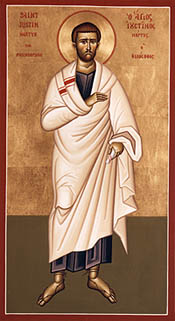|
|||
|---|---|---|---|
| This weekly bulletin insert complements the curriculum published by the Department of Christian Education of the Orthodox Church in America. This and many other Christian Education resources are available at http://dce.oca.org. | |||

The Church remembers a great Church Father, the second-century saint Justin the Martyr. Justin is sometimes called "The Philosopher" because he studied the great philosophies of his day (Stoicism and Plato's teachings, for example) with great care and seriousness. Only after this intense study, which showed him that Christianity was more complete and authentic than all philosophies, did he accept baptism and proclaim himself a Christian. Justin spent the rest of his life writing to explain Christianity and to draw people to the faith. He also described the way Christians worshipped in those very early days of the Church—a description remarkably close to the order of the Orthodox Divine Liturgy. The newspaper "USA Today" once carried a front-page story about people who choose to celebrate Easter in gatherings at home rather than attending a traditional church. They claim that their way of worship is "closer to the original" and by this they mean the early Church described in the New Testament. One person is quoted as saying that "if you look at the Bible, the church we have today is nowhere to be found." But what does the Bible say about the Church? What was the earliest Church like? First, we know that its form of worship was not spontaneous and free-form, as some people today assume. The Eucharist was central in the time of the apostles, and has remained central in all the centuries since. The bread and wine of the Eucharist were understood to be truly the Body and Blood of Christ right from the Church's beginning, because Christ Himself said, "This is My Body" and "This is My Blood." So Saint Justin wrote that at each Liturgy "...the food which is blessed by the prayer of His word, and from which our blood and flesh by assimilation are nourished, is the flesh and blood of that Jesus who was made flesh." Because the Eucharist was understood in this way, worship was reverent and orderly, just as in the Orthodox Church today. Another person quoted in the "USA Today" article claims that unlike the "modern, hierarchical" Church, her house church needs no "pastors and teachers who take over." Yet we know that the New Testament Church was hierarchical, and was led by pastors and teachers. Saint Paul outlines the duties of bishops and deacons--the hierarchical order--in I Timothy. Paul tells Timothy himself to "command and teach these things."
We also know that the early Church was governed by the teaching of the apostles. Paul exhorts the believers to "stand fast and hold to the traditions which you were taught by us, either by word of mouth or by letter" (II Thessalonians 2: 15). Those who want to "find" the early Church would do well to study Saint Justin's writings. He notes each element of worship in the Divine Liturgy during the second century, based on the worship of the apostles, and carried on today in every Orthodox Church. |
|||
